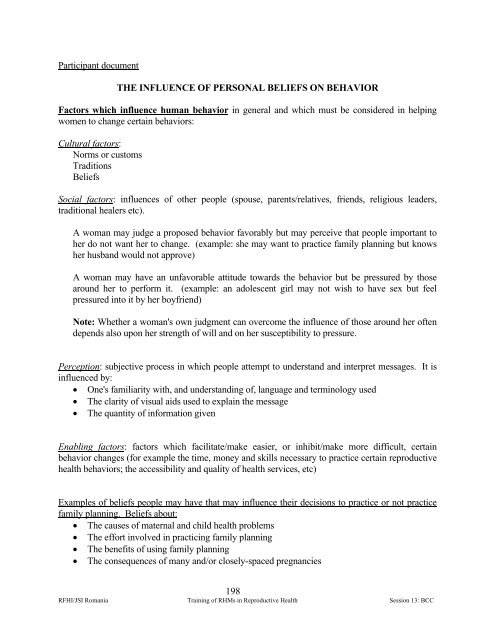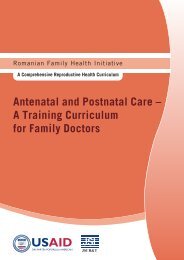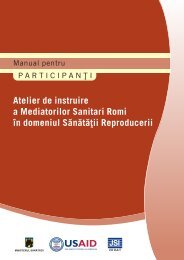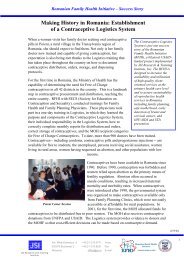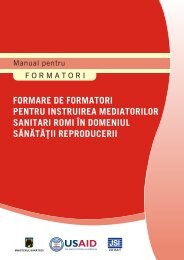Training of Roma Health Mediators in Reproductive Health
Training of Roma Health Mediators in Reproductive Health
Training of Roma Health Mediators in Reproductive Health
You also want an ePaper? Increase the reach of your titles
YUMPU automatically turns print PDFs into web optimized ePapers that Google loves.
Participant document<br />
THE INFLUENCE OF PERSONAL BELIEFS ON BEHAVIOR<br />
Factors which <strong>in</strong>fluence human behavior <strong>in</strong> general and which must be considered <strong>in</strong> help<strong>in</strong>g<br />
women to change certa<strong>in</strong> behaviors:<br />
Cultural factors:<br />
Norms or customs<br />
Traditions<br />
Beliefs<br />
Social factors: <strong>in</strong>fluences <strong>of</strong> other people (spouse, parents/relatives, friends, religious leaders,<br />
traditional healers etc).<br />
A woman may judge a proposed behavior favorably but may perceive that people important to<br />
her do not want her to change. (example: she may want to practice family plann<strong>in</strong>g but knows<br />
her husband would not approve)<br />
A woman may have an unfavorable attitude towards the behavior but be pressured by those<br />
around her to perform it. (example: an adolescent girl may not wish to have sex but feel<br />
pressured <strong>in</strong>to it by her boyfriend)<br />
Note: Whether a woman's own judgment can overcome the <strong>in</strong>fluence <strong>of</strong> those around her <strong>of</strong>ten<br />
depends also upon her strength <strong>of</strong> will and on her susceptibility to pressure.<br />
Perception: subjective process <strong>in</strong> which people attempt to understand and <strong>in</strong>terpret messages. It is<br />
<strong>in</strong>fluenced by:<br />
• One's familiarity with, and understand<strong>in</strong>g <strong>of</strong>, language and term<strong>in</strong>ology used<br />
• The clarity <strong>of</strong> visual aids used to expla<strong>in</strong> the message<br />
• The quantity <strong>of</strong> <strong>in</strong>formation given<br />
Enabl<strong>in</strong>g factors: factors which facilitate/make easier, or <strong>in</strong>hibit/make more difficult, certa<strong>in</strong><br />
behavior changes (for example the time, money and skills necessary to practice certa<strong>in</strong> reproductive<br />
health behaviors; the accessibility and quality <strong>of</strong> health services, etc)<br />
Examples <strong>of</strong> beliefs people may have that may <strong>in</strong>fluence their decisions to practice or not practice<br />
family plann<strong>in</strong>g. Beliefs about:<br />
• The causes <strong>of</strong> maternal and child health problems<br />
• The effort <strong>in</strong>volved <strong>in</strong> practic<strong>in</strong>g family plann<strong>in</strong>g<br />
• The benefits <strong>of</strong> us<strong>in</strong>g family plann<strong>in</strong>g<br />
• The consequences <strong>of</strong> many and/or closely-spaced pregnancies<br />
198<br />
RFHI/JSI <strong>Roma</strong>nia <strong>Tra<strong>in</strong><strong>in</strong>g</strong> <strong>of</strong> RHMs <strong>in</strong> <strong>Reproductive</strong> <strong>Health</strong> Session 13: BCC


